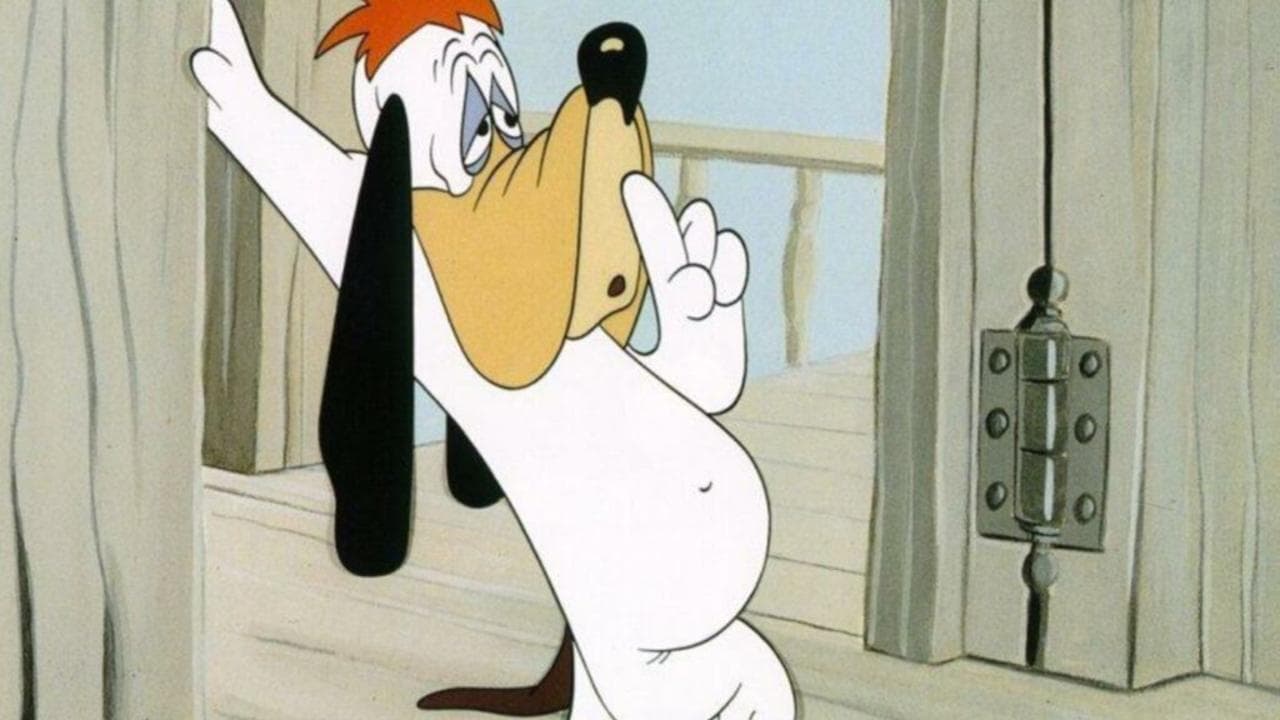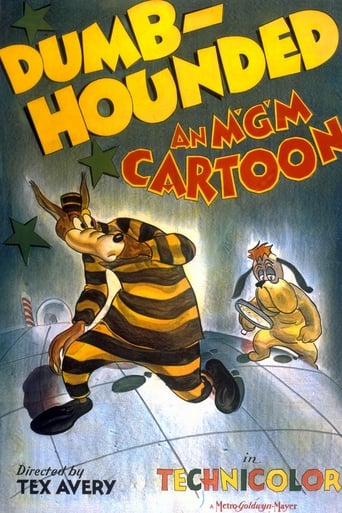ElMaruecan82
Have you ever had that dream where something was following you wherever you went? It can be a killer, a shadow, a dog, a scarecrow, a black rectangle stuck in the middle of the picture, the pattern of the dream (nightmare would be more appropriate) is that no matter how hard you tried to get rid of it or escape from it, it never leaves you. Tex Avery's third MGM cartoon "Dumb-Hounded" is based on that pattern, yet it never ceases to be anything less than a hilarious masterpiece.The Wolf, a prisoner escapes from Swing Swing prison (social club) then the police releases a troop of elite bloodhounds at his track, among them is the slow, neurasthenic, and droopy-eyed Droopy. This is a pivotal cartoon marking the entrance of the most emblematic character of Tex Avery (although he would appear more than ten cartoons after this one) and in case we hadn't noticed, he sets the tone by delivering the iconic "Hello, all you happy people. You know what? I'm the hero". Animation legend is on march… but a rather slow, cumbersome and burdensome march. Droopy isn't the fastest bloodhound out there, the bloodhounds were all freed but Drropy is far behind them, going slowly, taking a well-deserved halt behind a fire hydrant, after which his smiling face reddens, he exchanges a few barks with another dog, then follows the footsteps till a trashcan, from which a sign emerges with "I'm not here" then Droopy changes his direction, and the wolf gets to his apartment in some random building. Knock! Knock! He's got a visitor, guess who!Droopy informs the wolf that he's going to call the cops and asks the wolf to wait for him. The wolf promises not to move an inch, Droopy leaves. Now, the pattern of the short is simple: wherever the wolf goes, Droopy will pop up, but Tex Avery doesn't even let this escalate, the first attempt from the wolf is hilariously over-the-top (curtesy from IMDb quotes: "he Wolf goes out the window, takes a taxi to the train station, takes a train to the docks, takes a boat to the airport, and takes a plane to a remote cabin, where he finds Droopy") The perfect punchline comes with Droopy's laconic "You moved, didn't you?" but the wolf binds and gags Droopy then takes the same trip in reverse and the William Tell overture is played at higher speed.Droopy is in the apartment and asks the wolf if he's enjoyed the trip? The wolf wants explanation but Droopy tells him not to get too nosy. Indeed, you don't discuss the structure of the story, the wolf's role is to escape from Droopy and for Droopy, he states it clearly himself: "I'll surprise him like this all through the picture". The infernal chase takes us to the North Pole, to dark sewers and the situations gets so hellish for the wolf than he almost gets out of the frame, to one of the most memorable gags from an Avery cartoon. Avery acts like a sort of God-like figure with no indulgence whatsoever for his characters, in the previous cartoons, he showed no remorse in killing them, "Dumb-Hounded" showcases a treatment that can look worse than death by cartoon standards. Let's not get over-analytical of course, the film is never dark or ominous but there's a sense of impending doom over the shoulders of the wolf, that makes him within the fun of the situation, a really tragic character, without making Droopy a villain either, and it's all handled with funny one-liners such as "Peek-a-Boo" and "Here we go again, Boo!". It's all in these "Boos" that finally drive the wolf so crazy he decides to commit suicide. Indeed, after so many failing horizontal moves, he has no other choices by picking the vertical option, but that's underestimating Droopy who's also have a 'vertical' weapon against the wolf, he drops a huge boulder on him, and with his sad eyes, tell us: "yes, you're right. It is gruesome". The huge rock ends up the chase, and earns him the reward, a big bundle of money. Once again, Avery proves that the ending always makes the cartoon or carries almost half the legendary value, Droopy pauses, smiles at us, and jumps about in frenetic joy then pauses again and delivers his: "I'm happy". Besides establishing the wolf as a recurring character voiced by Frank Graham and Droopy as the perfect antihero voiced by Bill Thompson, Avery's approach to characterization gets more complex and fascinating. In "Blitz Wolf", the wolf made the show despite being the villain, in "The Early Bird Dood It", the status of hunter or hunted didn't prevent 'SPOILER' two characters to be gulped down at the end here again, Tex Avery doesn't care for conventions. Maybe that's why he mentions he's the hero but Droopy is almost the bad guy in the sense that we can relate to the wolf, and feel safe not to undergo the same situation, there's something just cathartic in this humor that translates in comedic terms the most tormenting and depressing aspects of life.Not to mention that it's a masterpiece of repetitive humor. Indeed, no matter the fact that you know Droopy will pop up, his appearance is always effective, the two characters are perfect foils one to another, Droopy is sympathetic but needs a worthy antagonist to shine, and the wolf, while prisoner, needs someone as tough as Droopy to be sympathetic. The perfect balance that explains why the later Droopy cartoons won't reach the same level, but we're not there yet, this is the third MGM Tex Avery and there are at least twenty cartoons before you'll notice a few drop in quality. This is really Golden Age material and the cartoon that should have made the Top 50 Greatest Cartoons list, instead of "Northwest-Hounded Police" (basically, a remake of "Dumb-Hounded").
ccthemovieman-1
I love the opening to this cartoon; an introduction, if you will, to the great character named "Droopy." Here he was called "The Happy Hound" but that changed quickly into the name we Droopy fans are all familiar with. Anyway, we see a bunch of dogs racing out of "Swing Swing Prison," chasing an escaped convict. Trailing the pack is a very slow hound, who turns to us with his very downcast voice, asks, "Hello, are you happy people? You know what? I'm the hero." Then, he just slowly saunters away. That's his introduction to us. Bill Thompson does a fantastic job with our hero's depressing-sounding voice. One of the most endearing aspect of these cartoons is Droopy giving asides to us, the audience. They're almost always hilarious. An early example in here: he and another dog bark at each other and the other dog walks away. Droopy turns to us and explains, "Just dog talk" and moves on.The gag in this story is the escaped convict being dogged by Droopy everywhere he tries to hide from the cops. The dog appears out of nowhere, even hundreds of miles away - in a flash. (You really have to see it to appreciate the humor.)This isn't just a cartoon which provides sight gags. It has that, plus a lot of puns, funny "asides" to the the viewers, comments on people and society, a sexy woman who gives us a good song....just a ton of entertainment from start to finish. Even when the jokes are corny, they admit it on screen to us!


